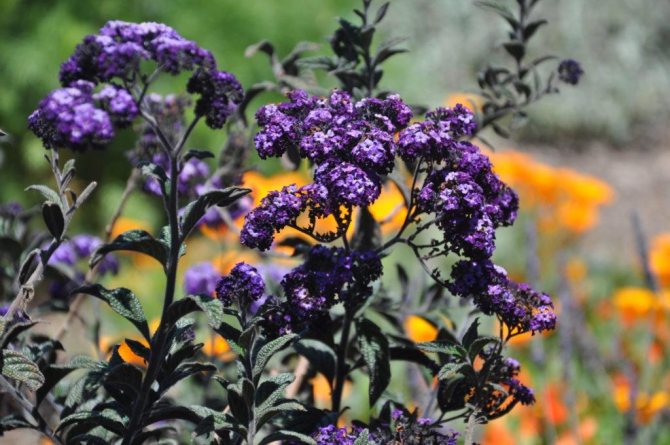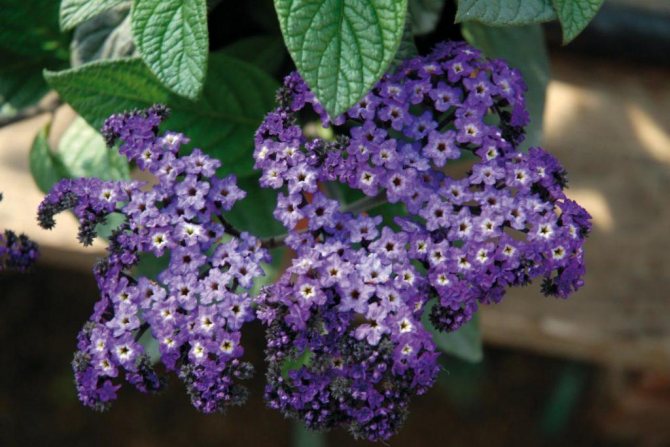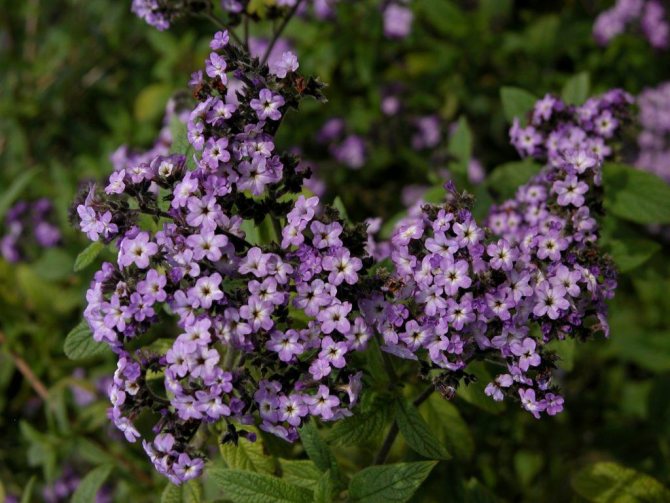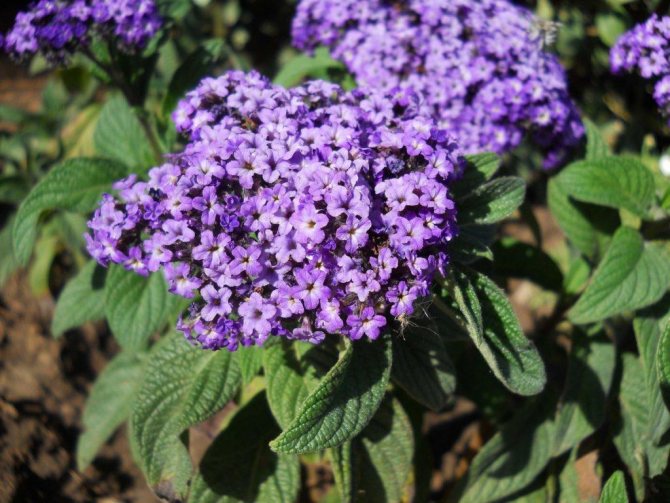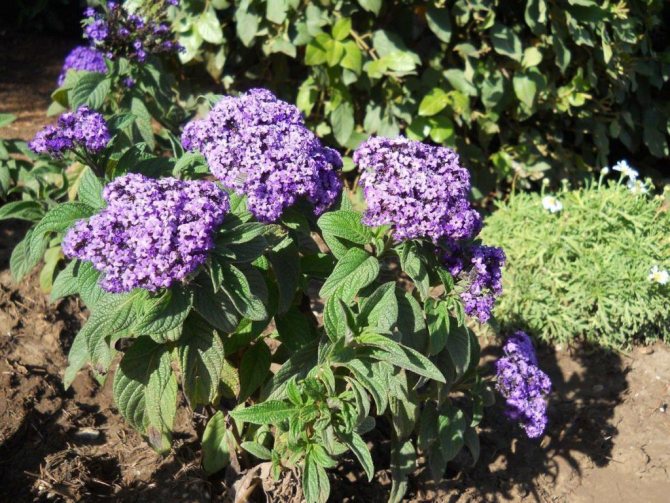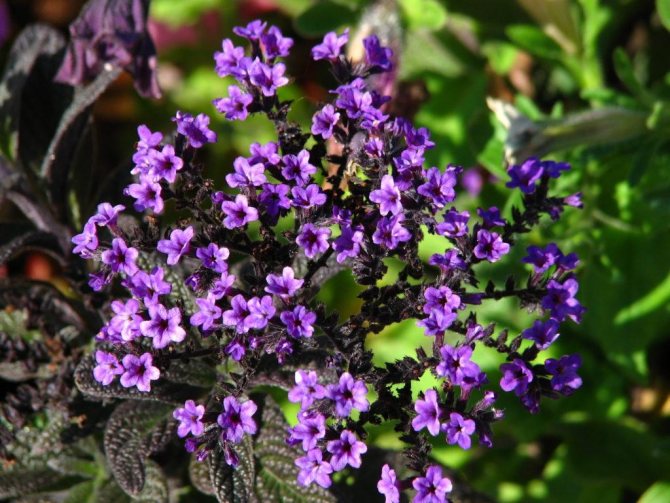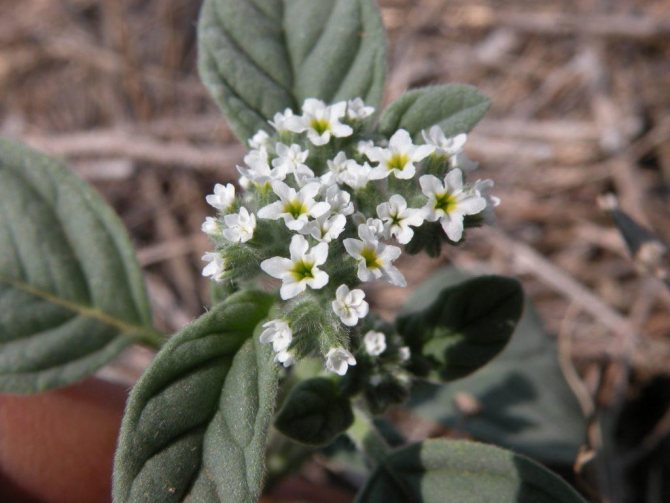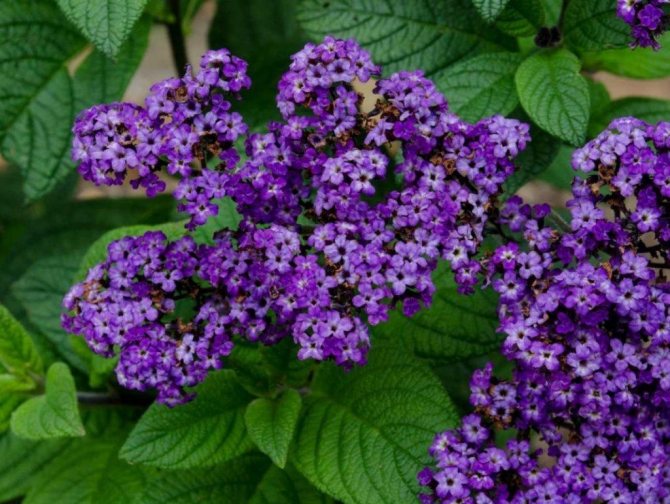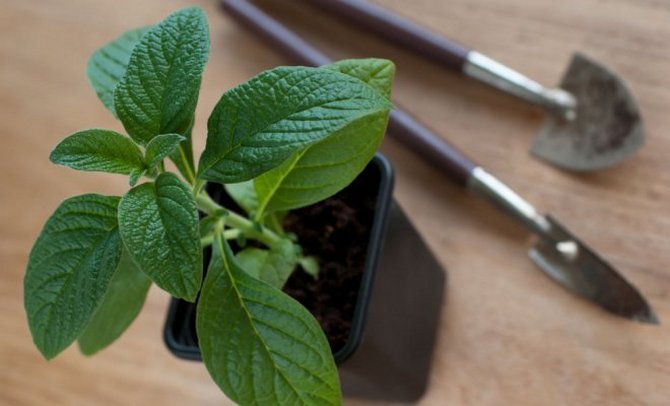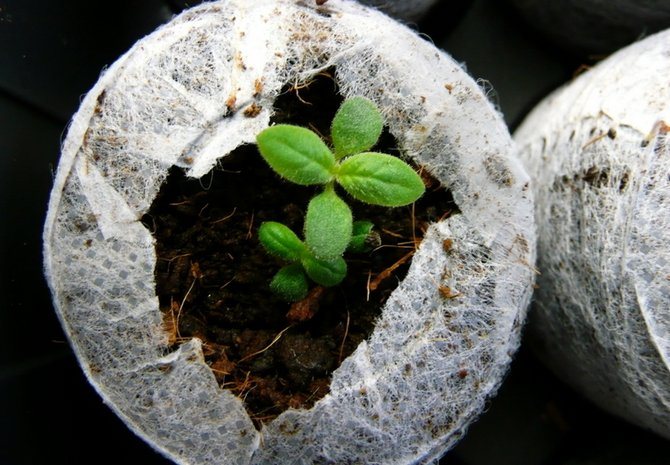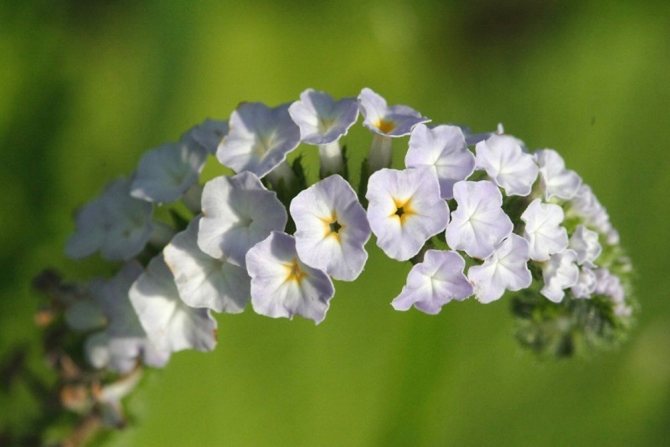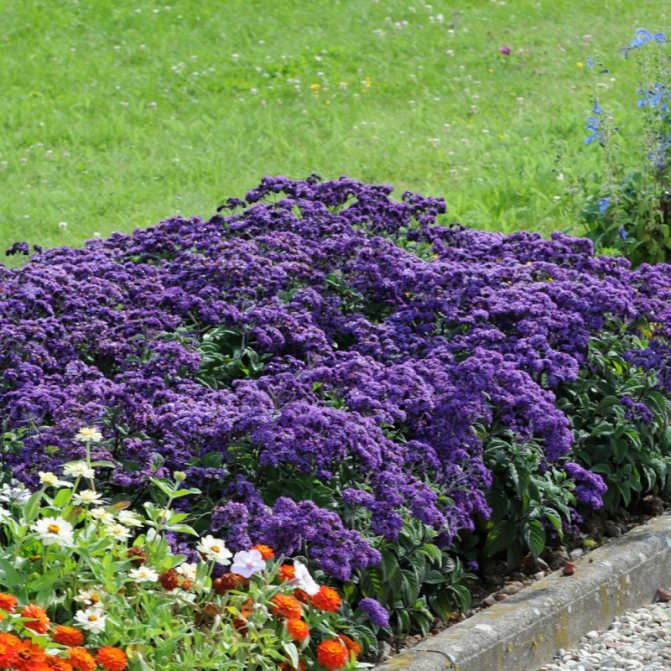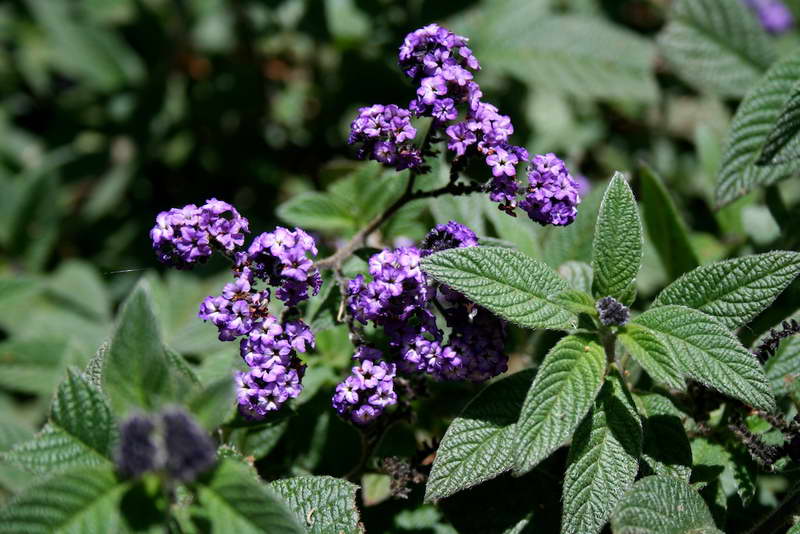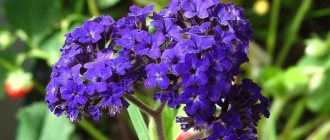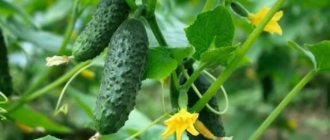Heliotrope is grown as a perennial houseplant and as a beautiful annual blooming on the site. The name "turning after the sun" is associated with the ability of the bush to unfold inflorescences towards the sun. This plant is undeservedly considered capricious, although problems can arise only at the stage of growing seedlings.

Heliotrope Peruvian
In Russia, heliotrope appeared long ago, in the 18th century. The plant was prized for its abundant flowering, stunning beauty of inflorescences and intoxicating aroma. For a long time the "lordly" plant was inaccessible to the people. In retaliation for this, he was nicknamed "lichen grass." In France, heliotrope is called "the herb of love", in Germany - "the herb of God."
Acquaintance with heliotrope
Heliotrope (Heliotropium) native to Peru and Ecuador, belongs to the Borage family, distributed in tropical and subtropical zones. In the middle lane and in the north of Russia, the thermophilic perennial is grown in flower beds only as an annual. The size of the bushes depends on the species and variety.
This plant is used in perfumery, traditional and official medicine. Self-medication is dangerous. Some species, such as Mediterranean heliotrope european (N. europaeum), poisonous, can affect the human nervous system. In the Middle Ages, heliotrope was considered a magical plant. People believed that on the full moon it could be used to expel evil spirits, acquire and protect wealth, or fly over the roofs of buildings. There is a belief that heliotrope strengthens marital relations and unites the family.
More than two hundred species have been described. It is a perennial with spectacular wrinkled leaves on short petioles and blue, lilac, lilac and even white fragrant flowers, collected in corymbose inflorescences. Hybrids (H. hibridum) bloom from early summer to late autumn. Most of the varieties are decorated with inflorescences from mid-summer until frost. During flowering, the air is filled with the aroma of vanilla. Unfortunately, not all modern varieties and hybrids have a strong aroma. Differences are found even within the same variety.
In our flower beds are planted heliotrope peruvian (H. peruvianum). It is also called heliotrope tree (H. arborescens). The height of the semi-shrub is up to 60 cm. Flowering continues from early summer to late autumn.
Description of the flower


The very name heliotrope literally translates as "one who turns after the sun." This plant is herbaceous perennial. Its height in nature reaches one and a half meters. When grown by gardeners, the length of the stems can be 60 cm. There are 300 species of this plant. Moreover, they are mostly wild. Homeland - North and South America, as well as the Mediterranean. It can grow in almost any sunny forest. Occurs in temperate zones. We grow it as an annual plant, as winters are too cold for it. At the same time, indoor versions of heliotropes live and develop well at home.
The heliotrope belongs to the gimlet family. This bush has large, pubescent, slightly wrinkled leaves. Their color is dark green. Both flowers and leaves are decorative. The flowers are small. Inflorescences are corymbose type. They are usually naturally dark blue or purple. Bred heliotrope white and blue.
List of popular varieties
- «Alba"(" Alba ") - heliotrope with white fragrant flowers. Persistent vanilla aroma.
- «Black Beauty"(" Black Beauty ") has purple flowers with a strong vanilla aroma.
- «Baby Blue"(" Baby Blue ") - variety (2003) with bright lilac-violet flowers. Compact bushes look beautiful in outdoor flowerpots.
- «Dwarf Marine"(" Dwarf Marine ") with bright blue flowers, bush height up to 35 cm.
- «Marine"(" Marine ") - a popular variety with large inflorescences 15 cm in diameter. Flowers are dark purple, dark green leaves have a purple hue. The bush is 45-50 cm high.
- «Mini Marine"(" Mini Marine ") - a modern variety up to 40 cm high with violet-blue flowers and dark green leaves with a noticeable purple tinge.
- «Sea breeze»Up to 45 cm high, has large blue inflorescences up to 12 cm in diameter.
- «Princess Marina"(" Princess Marina ") is a short (up to 30 cm) compact bush with violet-blue flowers with a faint aroma.
- «Regal Dwarf"(" Regal Dwarf ") - an amazing variety, which is distinguished by the compactness of the bush and the large size of fragrant dark blue flowers.
- «White Lady"(" White Lady ") - a variety with pink buds, blossoming white flowers.
There is a variety with golden yellow leaves ("Albert Delaus").
This year on February 26, I sowed the seeds of four varieties of heliotrope. These are "Sea Breeze", "Cherry Pye Marine", "Marine" and a Chinese variety, the name of which is written in hieroglyphs.
Landing
It is better to purchase seedlings from a trusted manufacturer. In our country, in the open field, heliotrope is grown as an annual.
Reproduction methods
You can grow seedlings yourself. Heliotrope is propagated in two ways:
- cuttings,
- seeds sown in spring in a greenhouse or other warm place.
Cuttings
Mother plants should go through a period of low temperatures before cutting the cuttings. Therefore, they are stored all winter at a temperature of 8-12 degrees Celsius, preferably in a greenhouse or on a window, and watering during this period is rather moderate. Cuttings are taken from the tips of the shoots in March and rooted in a mixture of peat and sand.
Herbaceous cuttings are dipped in a rooting agent and placed in the ground. The rooting process takes place in a humid environment at a temperature of 20-22 ° C. The cuttings are kept covered with film, in a slightly shaded place. After 3-4 weeks, the rooted seedlings can be replanted. When new leaves begin to appear, the seedlings are transplanted into pots with fertile soil, placed on a sunny window. At the end of April, you can transplant the seedlings into large pots.


Seeds
Growing heliotrope seedlings from seeds:
- Before sowing, it is better to keep the seeds in the refrigerator for a week (February).
- Seeds are sown in spring (March) in boxes with soil mixed with rotted compost and sand. Proportions for soil: compost, garden soil, sand and peat in a ratio of 3: 1: 1: 1. The soil for sowing seeds must be permeable, therefore, the universal soil must be mixed with sand.
- The seeds are not covered with earth, only slightly pressed into the soil. To ensure a sufficient level of humidity, it is worth covering the box with foil, remembering about airing.
- We put the box in a bright room at room temperature. It is important to maintain the correct temperature during germination - preferably 20 ° C. Seeds develop long and unevenly. Under these conditions, heliotrope seeds germinate within 3-4 weeks.


- A month later, the seedlings dive, transplanting into pots.
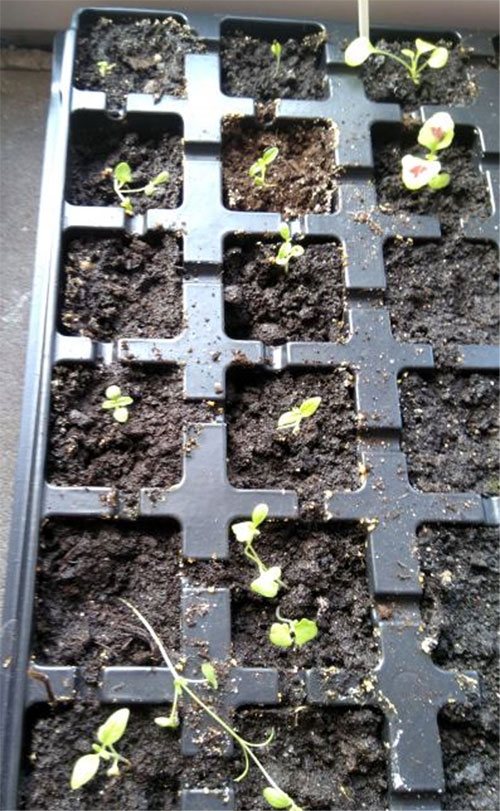

- Ready-made seedlings can be planted in the ground after the last frost (mid - end of May). Seedlings can be pinched to help plants bush better.


Landing time and scheme
Seeds should be sown early, preferably from January to March. It is better to plant heliotrope seedlings in open ground in mid or early June.
Attention! Heliotrope is a frost-sensitive plant, so attempts to plant it outdoors before May 15 may end badly.
The optimal distance for planting seedlings is 25 by 25 centimeters.


Further, as they grow, the plants occupy a large area, gradually expanding, as shown in the following photos.


Landing requirements
Heliotrope prefers fertile, humic, well-drained soils. The plant grows best in sunny places.It is necessary to remember about abundant watering, the use of appropriate fertilizers for flowering plants. Before planting, the flower bed should be cleaned, weeded, and enriched with well-rotted compost.
The name alone shows that the heliotrope loves the sun. Although the plant likes sunlight, it thrives better under a roof, where it is not exposed to direct sunlight and rainfall, which is very damaging to flowers. Better to choose a slightly shady position in the garden, especially at noon.


Planting in balcony pots, boxes
Wooden crates are best for growing balcony plants. Plastic boxes are lightweight and easy to keep clean, but the thin walls heat up quickly when exposed to sunlight. The soil dries quickly and the roots of the plants heat up. The bottom of the box requires holes with a diameter of 1 cm to prevent excess water from accumulating and causing root rot.
The soil in the containers needs to be replaced every year because the plants extract almost all the nutrients from it during the season. The best soil for balcony boxes is garden soil and compost mixed with turf soil and sand (ready-made mixtures are sold at garden centers).
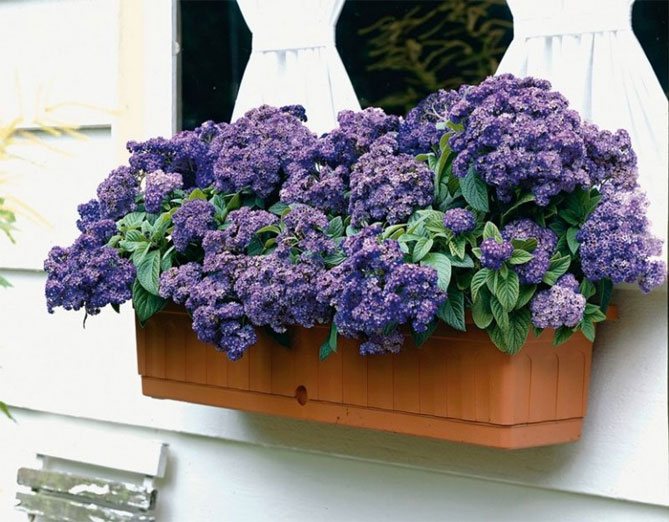

Before pouring the soil into containers, cover the holes in the bottom with pieces of a broken pot or glass so that excess water does not accumulate. Then a 1 cm thick drainage is poured - a layer of coarse gravel, and the container is filled with soil.
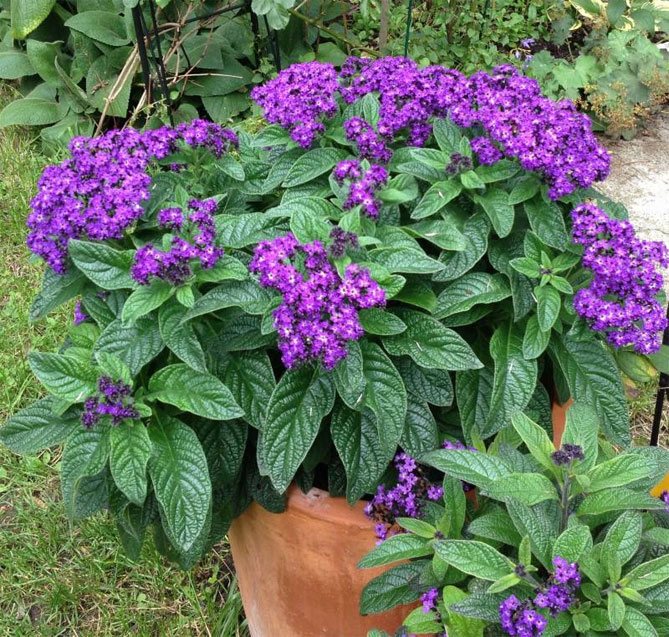

Growing heliotrope from seeds
With seed reproduction, heterogeneous offspring is possible. However, for many amateur flower growers, this is the only way to get heliotrope seedlings.
From sowing to the beginning of flowering, it takes from 14 to 40 days. The best time to sow seeds is during the period from the second half of February to mid-March... When soaked in stimulants (for example, in a solution of zircon), seedlings germinate more actively, often on the 8th - 10th day.
For seedlings, I take deoxidized high-moor peat, to which I add a small amount of sand. It is desirable to disinfect the soil mixture by steaming. You can spill it with a hot solution of potassium permanganate. The soil must first be moistened and lightly tamped.
It is more convenient to sow seeds along the furrows, because this simplifies the further care of the seedlings. Sowing is superficial. I immediately spray the grooves with the sown seeds with water from a spray bottle. It can be lightly powdered with crushed peat or sifted soil in a layer of 1 mm. Without this, the roots of individual seedlings do not have time to go deep into the soil, which is why the seedlings fall. Then you need to carefully give them a vertical position and push a little earth to the exposed roots. I use toothpicks for this.
The container is covered with glass or other transparent lid, and then placed in a warm place. If you create a greenhouse effect, then the seedlings will appear faster and more amicably.
I remove the bag (glass) when most of the seedlings are getting stronger. This happens about three to four weeks after the first shoots appear.
I dive the grown heliotrope seedlings into individual pots with a diameter of 8 - 10 cm. Growing seedlings need regular watering and good lighting.
To grow a lush bush with a large number of inflorescences, you need to trim the ends of all shoots. This provokes tillering, new side branches appear. After that, the bush will grow not only upwards, but also in breadth.
Unfortunately, not all purchased seeds germinate well. Yours are better. They can be collected if you are not in a hurry to cut off the inflorescences after the end of flowering. The seeds are poured out of the blackened seed pods, after which they are dried and stored until sowing.
Diseases and pests
Insufficient or improper care of heliotrope can provoke the appearance of the following diseases:
- the appearance on the leaves of spots of gray rot.The disease may appear due to the presence of the bush in conditions of excessive humidity or in a dark room;
- lethargy and falling leaves - lack of moisture;
- yellowed and fallen lower leaves - excessive watering and rotting of the root system;
- dry or folded tips of the leaves - too high an indicator of dry air;
- yellowed or lightened leaves - lack of light or excessively high temperature.
Also, the "sunny tree" can attack the following pests:
- Whitefly. If you notice that small white midges are flying around the bush, and the leaves have become sticky, you should immediately remove the diseased leaves and treat the plant with actellik.
- Spider mite. Too high temperature conditions and lack of moisture lead to the appearance of this pest. Remove leaves damaged by a spider mite (they are yellow) and treat the bush with an insecticide solution.
- Aphid. They remove the pest mechanically or act in the same way as in the previous case.
By observing all the rules of growing and caring for a solar tree, you will receive beautiful fragrant flower already in the first year of planting.
Cutting heliotrope
Heliotrope is beautifully cut. You can quickly root even cut tops of shoots with fading inflorescences. To do this, they are buried 1.5 - 2 cm into the soil in a pot and covered with a glass jar or bag on top (for a greenhouse effect).
Cuttings are also taken from perennial mother plants, which give many cuttings in spring. The most successful time for grafting is end of February - mid June... Cuttings must have at least 3 internodes. It is better to remove most of the leaves, rather than wait for them to dry out and fall off. The base of the cutting can be treated with a root stimulant. For successful rooting, sufficient soil moisture, diffused light and an air temperature of about 22 - 24 ° C are needed.
Roots appear in 15 to 20 days. Rooted cuttings are planted in individual flower pots, the first few days are shaded and sprayed with water 2 - 3 times a day. Soon they begin to form a bush (pinch the ends of the shoots) or a tree (tie the main shoot to the support, blind the lateral buds).
Propagation by cuttings
To propagate heliotrope, choose young shoots that have 2-3 internodes. It is desirable that the length of the branches reaches 4–5 cm. Remove the lower leaves of the cuttings, and cut the upper ones in half. Treat the cut sites with any growth stimulant, for example, "Zircon" or "Kornevin". Root the workpieces immediately in peat cassettes or tablets. Then future flowers will not suffer during the pick.
If there are no peat tablets, then plant the cuttings in a universal mixture, but treat it with Fitosporin to protect the plants from pathogenic microbes. After planting, cover the plants with plastic or glass, and place the greenhouse in a warm and bright place. If you propagate a heliotrope flower in winter, be sure to illuminate the culture with a phytolamp for about 8-10 hours a day.
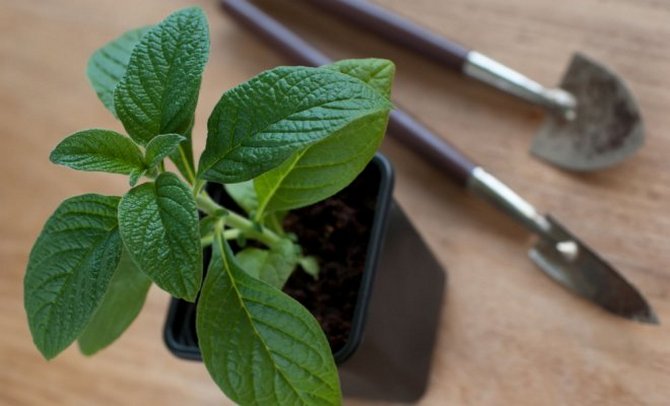

Spray the soil regularly with warm water from a spray bottle, and wipe off condensation from the shelter. When the cuttings take root, dive them together with tablets (or an earthen lump) into individual pots with a diameter of 7-10 cm. After a week, pinch the top of the young bushes. This will provoke the growth of lateral shoots, as well as the laying of flower buds. In late spring or early summer, plant the plants outdoors.
Features of growing in a flower garden
A place... Heliotrope is planted in open ground at the beginning of June, when there is no longer a threat of recurrent spring frosts. A well-lit or slightly shaded place is suitable for photophilous and thermophilic heliotrope. The scorching rays of the sun can cause the flowers to burn out.
Landing... The soil should be loose, fertile, enriched with humus.When planting, I add a handful of lingering horse manure and leaf humus to each hole. Care makes it easier to mulch the soil under the plant.
Watering and feeding... Heliotrope needs to be watered often, but the flower garden cannot be turned into a swamp. They are fed with those fertilizers for flowering shrubs, which are dominated by potassium and phosphorus. If you overfeed with nitrogen, then the plant will fatten and grow green mass to the detriment of flowering. It is helpful to spray the foliage in the early morning.


Heliotrope in a flower garden
Heliotrope is a wonderful plant that will decorate any area. It is grown in large flower beds, borders and flower beds. Plant pots can be placed on an open balcony, patio, or in a garden under trees. Heliotrope looks very nice under sea buckthorn.
I once saw a stunning rose garden, where heliotrope bushes bloomed next to white, pink and cream roses. This plant is in harmony with pelargonium, salvia, begonia, coleus, cineraria and petunia. Its beauty is emphasized by bright yellow and orange flowers (marigolds, calendula, etc.). You can pick up garden plants with blue and blue flowers. For example, flax, borago (cucumber grass), lobelia or cyanosis. Heliotrope will beautify the garden of scents as well.
Caring for heliotrope in the garden
In order for the plant to grow normally and bloom profusely, competent care is needed. You can take care of seedlings grown from seeds and seedlings obtained from cuttings according to the same scheme. Attention should be paid to watering, loosening and feeding.
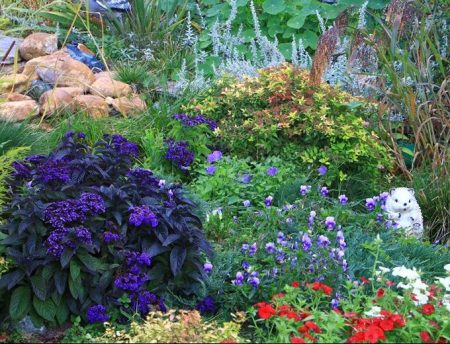

Watering
Heliotrope is a moisture-loving plant. The soil around the plant should always be moist, but heliotrope does not tolerate stagnant moisture. You need to focus on the condition of the soil. If the topsoil has dried out by 2-3 cm, then it's time to water. On hot days, it is necessary to increase the humidity around the plant by spraying. This should be done with warm water in the early morning and late evening.
Loosening and mulching
After watering, the soil between the flowers should be loosened, combining this procedure with weeding. The mulching procedure allows you to reduce the number of loosening and watering.
When to plant heliotrope for seedlings
Delphinium - care and cultivation from seeds
The seedlings must be planted at the right time to germinate and develop into a healthy and flowering shrub.
Flowering after planting in a permanent place of seedling growth will begin after 4 months. Perhaps a little earlier. Therefore, the right time for sowing is late February or early March. For seedlings, it is better to use purchased seeds. Those that gather independently in Russian climatic conditions are unlikely to sprout, since they have little germination. Before planting, you can soak the seeds for 24 hours in warm water, to which you can add a growth stimulant.
Soil preparation and containers
The soil for seedlings should contain peat and some sand, which must be steamed in order to disinfect to eliminate potential pathogens. Prepared compacted soil is poured into a previously prepared container, then it is necessary to sow the seeds, sprinkle them with earth and cover them on top with simple glass or plastic wrap.
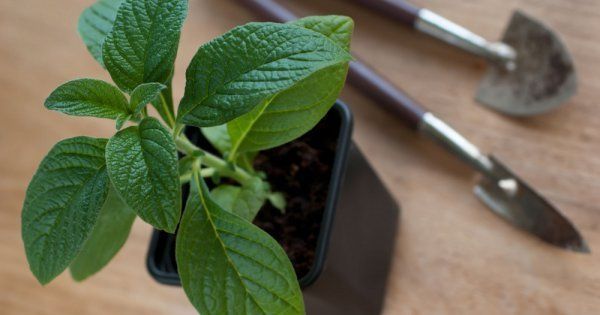

Planting seedlings
Seedlings appear in one or three weeks. After pecking them, the containers are placed on the windowsill so that the seedlings receive a sufficient amount of sunlight.
Attention! Planting containers must be thoroughly rinsed and disinfected using soda or potassium permanganate.
Combination with other plants
Heliotropes are a wonderful crop that goes well with many plants. For example, begonias, coreopsis, rudbeckia, coleus and many other flowers can be planted nearby. Very effective compositions are obtained by planting heliotropes with cineraria and petunias.There are a lot of possible combinations.
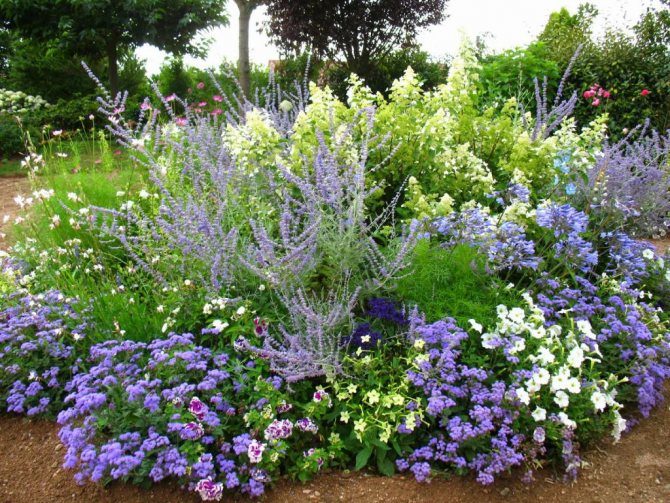

The culture is very successfully used in landscape design. Its long and bright flowering allowed it to take pride of place among the plants used to decorate personal plots. With the help of heliotropes, beautiful flower beds are made and flower borders are formed. Flowers look especially impressive against the background of a bright green lawn. Plants for home cultivation in pots are no less interesting. They are used to decorate balconies and terraces. In this case, they are given the shape of a small tree on a trunk.
Seed collection
Growing heliotrope is not difficult. But collecting plant seeds is not so easy. Getting your own seeds does not always work well. And the reason for this is our climate. In the conditions of our latitudes, the seeds do not have time to ripen, so experienced gardeners do not recommend wasting time and effort on a hopeless process. It is easier to purchase certified seed in specialized stores. Good quality seeds will make good plants grow. If you want to try your hand at being a breeder, you need to wait for the period when the inflorescence will not only wither, but also turn black. After that, you can cut it off and open the capsules in search of seeds, which must be thoroughly dried. They must be stored in cardboard boxes before sowing.
Planting seedlings in open ground
Young bushes need to be hardened. Take it outside for a couple of hours a week before landing.
Optimal planting times
Young bushes are planted in spring, when the ground stops freezing at night. In central Russia, this happens in May.
Site selection and soil preparation
For planting, a well-lit place is chosen, without stagnant water. Litmus grows on nutritious soil with a lot of humus. The earth should be loose, crumbly. If the substrate is poor, leaf humus or rotted manure is spread on the bottom of the planting pits.
Correct fit
Leave 30-40 cm between the holes. Step-by-step planting:
- Add humus to the pit
- Cross the bush along with the earthen lump. This method of transplantation will help the dye litmus to adapt faster and accelerate growth.
- Leave the root collar at the same level.
- Press the trunk circle with your palms.
- Drizzle with a little warm water.


Heliotrope flower, features, benefits and harms
The people nicknamed it: the dyeing litmus, the herb of God. The flower has found its application in landscape design, medicine, and perfumery.
Reaches 20-60 cm, with erect shoots. Emerald leaves with a bluish tint obovate, with a downy. Located on shortened petioles. They are wavy or wrinkled.
The flowers are violet or dark blue. Varieties with snow-white, pale blue buds have also been bred. They contain aromatic substances used by perfumers in their constituent components. Flowering can be observed for about 4 weeks. After it, in place of inflorescences, a fruit appears - coenobium. When ripe, it breaks down into 4 parts containing seeds.
Some varieties are poisonous and can paralyze the central nervous system. They are not grown as horticultural or indoor crops. Poisons (cinoglossin, laziocarpine, heliotropin) are used in alternative medicine to heal from:
- worms;
- prostate adenoma;
- urolithiasis;
- depriving;
- benign neoplasms;
- open wounds;
- warts.
This remedy is not used in traditional medicine. Any treatment must be agreed with a doctor so as not to harm the body.
In greenhouses, the flower can grow for several years. In gardens, it is planted as an annual, because it does not differ in winter hardiness.


